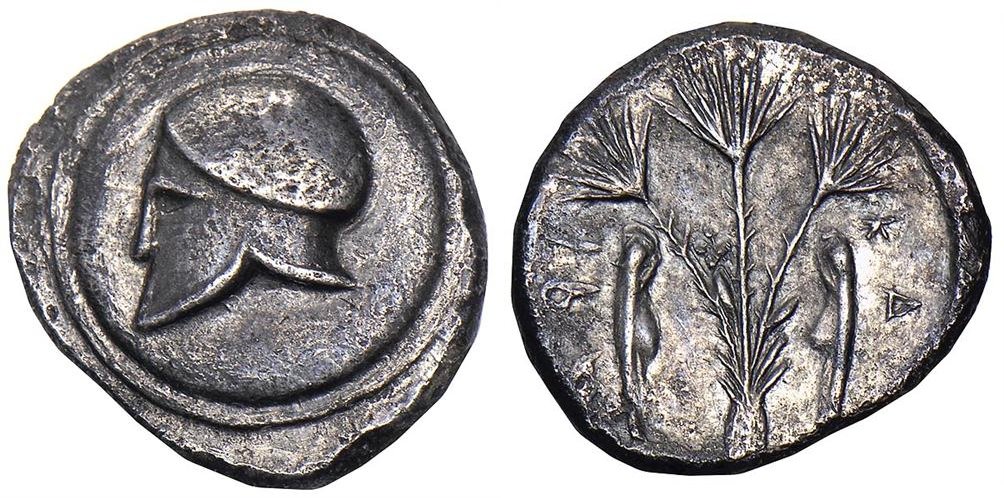Camarina, silver, didrachms (492-485 BCE)
From SILVER
492 BCE - 485 BCE Silver 1,625 kg
Description
| ObverseInscription or printing placed on the obverse.: | Corinthian helmet left, superimposed on a circular shield with convex surface and flat rim |
| ReverseInscription or printing placed on the reverse.: | KAM – API (Greek).Dwarf palm tree with three branches of fan-shaped leaves, each branch marked with protruding spines, to left of central branch, small group of fruits, flanking tree, a pair of greaves |
Mint and issuing power
| MintIdentifies the place of manufacture or issue of a numismatic object.: | Camarina | Ancient regionAncient region.: | Sicily | Modern countryModern country: Italy | AuthorityIdentifies the issuing power. The authority can be "pretended" when the name or the portrait of X is on the coin but he/she was not the issuing power. It can also be "uncertain" when there is no mention of X on the coin but he/she was the issuing power according to the historical sources: |
Chronology
| FromIdentifies the initial date in a range assigned in a numismatic context. | 492 BCE | toIdentifies the final date in a range assigned in a numismatic context.. | 485 BCE | PeriodTime period of the numismatic object.: Archaic until 480 BC |
Physical description
| MetalThe physical material (usually metal) from which an object is made.: | Silver |
Median weightMedian of the weights of numismatic objects (in grams). in grams | 8.70 | DenominationTerm indicating the value of a numismatic object. Examples: tetradrachm, chalkous, denarius.: | didrachm |
StandardStandard.: |
Image

S1688 Camarina 492-485.jpg [1]
References
| Die study referencePublication of the study: | Westermark - Jenkins 19801Westermark - Jenkins 1980, n° 1-9 | ||
| Coin series referenceReference to coin series study: | |||
| Coin series web referenceCoin series web references: | |||
Obverse dies distribution
| FrequencyFrequency of specimen in distribution. ᵖ | Number of obversesNumber of obverse dies. ᵖ (o) | % (o) | Number of coinsNumber of coins. (n) | % (n) | Die nameName(s) of the die(s). |
| 1 | 3 | 42.86 | 3 | 15.79 | 2, 3, 4 |
| 3 | 1 | 14.29 | 3 | 15.79 | 1 |
| 4 | 2 | 28.57 | 8 | 42.11 | 5, 6 |
| 5 | 1 | 14.29 | 5 | 26.32 | 7 |
| Total | 7 of 7 | 100.01 | 19 of 19 | 100.01 |
Reverse dies distribution
no distribution is available
Quantification
| Number of obversesNumber of obverse dies. ᵖ (o) | 7 | Number of singletons (o1)The number of singleton coins. ᵖ | 3 |
| Number of reverse diesNumber of reverse dies. (r) | 7 | Number of coinsNumber of coins. (n) | 19 |
| Coins per obverse dieNumber of coins per obverse die. (n/o) | 2.71 | Coins per reverse dieNumber of coins per reverse die. (n/r) | 2.71 |
| Reverse per obverse ratioRatio of obverse dies divided by reverse dies. (r/o) | 1 | Percentage of singletons (o1)number of coins (n) divided by the number of singletons (o1) ᵖ | 42.86 % |
| Original number of dies (O) (Carter 1983 formula)The estimation of the number of coins according to Carter 1983 ᵖ | 9.34 | Coins struck if 20,000 as average productivity per dieCoins made if the average productivity for obverses (according to Carter) is 20,000. ᵖ | 186,800 |
| Original number of dies (O) (Esty 2011 formula)The estimation of the number of coins according to the singleton formula in Esty 2011 ᵖ (O) | 11.08 | Survival rate if 20,000 as average productivity per dieSurvival rate if average productivity is 20,000. ᵖ | 0.00010 |
| Coverage (o = % of O) (Esty 1984 formula)Esty 1984 - coverage (% of O) ᵖ (o = % of O) | 84.21% | Die productivity if survival rate 1/2,000Average productivity if survival rate is 1/2,000. ᵖ | 4,068.52 |
| Weight of silver (in kg) if 20,000 coins per die (O = Carter formula)Carter 1983 * Median weight * 20000 (*10 if gold or electrum) ᵖ | 1,625 kg <br /> 1,625 kg | Die productivity if survival rate 1/5,000Average productivity if survival rate is 1/5,000. ᵖ | 10,171.31 |
Remarks
Most likely one single workstation
References
- ^ Westermark, Ulla - Jenkins, Gilbert Kenneth (1980), The Coinage of Kamarina, RNS 9, Londres, 283 p., 40 pl.